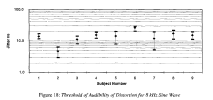Usual stereo mastering is for an image to be formed in front of the speaker and my guess is if it is forming behind the head then either the speakers are wired out of phase where the soundstage can be pretty weird and seem like coming from inside the head Or there is some rear wall reflections forming an image.
Just goes to show that you really have not heard a good system playing in a room that has been treated well. I can assure you that there were zero reflections from any of the walls. The rear of the auditioning seat was covered with thick curtains. That is all. How can they reflect anything.
Good stereo audio systems can go to the extent of delivering near 3D sound. Even my relatively inexpensive system projects sound up to level with my ears when I sit some 8-10 feet away from the speakers. I have 1/3rd sound absorbers on the side walls. That is all. Again, the rear of my couch is just curtains and a open window. In addition to that, sometimes, my system positions sound far below the speakers. In literally every song, I can hear and perceive depth and separation between vocal and instruments. In a song from the Tamil movie 'Allay Payudhe', I know exactly where and when the temple bells will ring. I have experienced these and written about them innumerable times on this forum.
Wired out of phase? My god! This is what I call coming to wild conclusions in a hurry.
Cheers.
This is interesting. I’ve heard quite high end vinyl setup ........
I’m interested to learn what was your setup in this case including source and source media.
Please search for my article/review on Audire Systems that I wrote a few years ago. It is there.
many digitally mastered albums still sound better on LPs due to compression methods used on the retail master for digital. Many audiophiles in the west buy LPs of pop music only due to this problem. Adele is a good example of how bad the digital version sounds.
It is your belief that LPs sound better. I respect that.
Allow others to believe in and enjoy what they think is right. Knowingly or unknowingly you yourself are disparaging digital systems for compression. As I have mentioned before (and you can look up the net), the compression in LPs is far worse. Both the dynamic range and lower and higher frequencies are cut off. This sounds pleasant to your and other's ears. I have no issues with that.
I enjoy the full bandwidth of a digital copy DACed well and played through well engineered pre-and power amplifiers. I like that I get the same sound irrespective of how many times I play it without the fear of any any hiss or skipping. It also allows me to experiment with electronics and speakers to eke out that little extra knowing my source is one 100% the same. Dynamics, frequencies, and gain amplitude never change.
It gives me great pleasure to hear the same sound at the same place in the soundstage where I know it will happen every time. That is how I enjoy music. Dont you think I should be allowed to do with the belief that my system is good? Not that I need any assurance from anyone. I have researched the technologies behind analog and digital system for over 5 years, and I have done enough auditioning including of very expensive systems. I know what is good.
And I am certainly not going to be bothered by a few bad apples. Those are there in every field.
And yes, someone mentioned that we seem to lost the original plot in this thread. All I can say is that a hard disk specially made for music and all the arguments in it's favor is so laughable that it is not even worth discussing. I certainly have no intention of getting into any discussion on that. Also it is quite sad that any discussion of anything to do with digital system seem to always end up as an analogue vs digital skirmish. But, so be it.
Cheers
Last edited:


